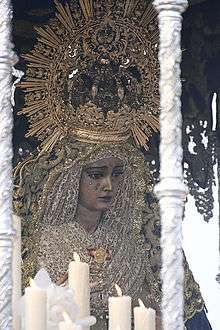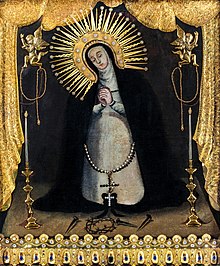Friday of Sorrows
The Friday of Sorrows is a solemn pious remembrance of the sorrowful Blessed Virgin Mary on the Friday before Palm Sunday held in the fifth week of Lent (formerly called "Passion Week"). In the Anglican-Catholic Divine Worship: The Missal it is called Saint Mary in Passiontide and sometimes it is traditionally known as Our Lady in Passiontide.

In certain Catholic countries, especially in Mexico, Guatemala, Italy, Peru, Brazil, Spain, Malta,[1] Nicaragua and the Philippines, it is seen as the beginning of the Holy Week celebrations and termed as Viernes de Dolores (Friday of Sorrows).[2] It takes place exactly one week before Good Friday, and concentrates on the emotional pain that the Passion of Jesus Christ caused to his mother, the Blessed Virgin Mary, who is venerated under the title Our Lady of Sorrows.
In certain Spanish-speaking countries, the day is also referred to as Council Friday, because of the choice of John 11:47-54 as the Gospel passage read in the Tridentine Mass on that day (which is now read in slightly expanded form on Saturday of the fifth week of Lent), which recounts the conciliar meeting of the Sanhedrin priests to discuss what to do with Jesus.
Like all Fridays in Lent, this Friday is a day of abstinence from meat, unless the national episcopal conference has indicated alternative forms of penance.[3]
A similar commemoration in sympathy with the Virgin Mary under the title of Our Lady of Solitude is held on Black Saturday.
History

In the Roman Catholic Church, the practice of religious veneration towards the Blessed Virgin Mary was designated on any given Friday, which was initiated by the Friday before Holy Week as well as Good Friday itself, after Palm Sunday.
In 1727, Pope Benedict XIII extended a feast commemorating the sorrowful Virgin Mary to the whole of the Latin Church, assigning to its celebration the Friday in Passion Week, one week before Good Friday.[4]
In 1954, the feast still held the rank of major double (slightly lower than the rank of the 15 September feast) in the General Roman Calendar. Pope John XXIII's 1960 Code of Rubrics reduced it to the level of a commemoration.
In 1969 the celebration was removed from the General Roman Calendar as a duplicate of the feast on 15 September.[5] Each of the two celebrations had been called a feast of "The Seven Sorrows of the Blessed Virgin Mary" (Latin: Septem Dolorum Beatae Mariae Virginis) and included recitation of the Stabat Mater as a sequence. Since then, the 15 September feast that combines and continues both is known as the Feast of "Our Lady of Sorrows" (Latin: Beatae Mariae Virginis Perdolentis), and recitation of the Stabat Mater is optional.
Observance of the calendar as it stood in 1962 is still permitted in the Traditional Roman Rite, and even where the calendar as revised in 1969 is in use, some countries, such as Malta, have kept it in their national calendars. In every country, the 2002 edition of the Roman Missal provides an alternative collect for this Friday:[6]
O God, who in this season give your Church the grace
to imitate devoutly the Blessed Virgin Mary in contemplating the Passion of Christ, grant, we pray, through her intercession, that we may cling more firmly each day to your Only Begotten Son and come at last to the fullness of his grace.
In the last edition of the Tridentine Mass, published under John XXIII in 1962, the Collect was as follows:
O God, in whose Passion, according to the prophesy of Simeon, the sword of sorrow didst pierce the most sweet soul of the glorious Mary, Virgin and Mother; mercifully grant that we who call to mind with veneration her anguish and suffering, by the glorious merits and prayers of all the Saints who faithfully stood beneath the cross interceding for us, may obtain the blessed fruit of Thy Passion, Thou Who livest and reigneth with God the Father, in the unity of the Holy Ghost, ever one God, unto ages of ages. Amen.
In 2015 Divine Worship: The Missal for Anglican use Catholics restored the observance on the Friday in Passion Week, and provided propers including the Introit Stabant iuxta crucem (Jn 19:25; Ps 56:1), and a modified form of the 1962 Collect
O LORD in whose Passion, according to the prophecy of Simeon, the sword of sorrow did pierce the most loving soul of thy glorious Virgin Mother Mary: mercifully grant that we, who devoutly call to mind the suffering whereby she was pierced, may, by the glorious merits and prayers of all the Saints who have stood beneath the Cross, obtain with gladness the benefits of thy Passion; who livest and reignest with the Father, in the unity of the Holy Spirit, ever one God, world without end. Amen.
It also restored the Gradual Dolorosa et lacrimabilis, the Tract Stabat sancta Maria (Cf. Lam 1:12), the Sequence Stabat Mater dolorosa, the Offertory Recordare, Virgo Mater (Cf. Jer 18:20), the Communion Felices sensus beatae Mariae and the other requisite proper prayers.
Celebration of Friday of Sorrows in Malta, Spain, Portugal, Mexico, Panama, Costa Rica, Colombia, Venezuela, Ecuador, Nicaragua, Peru, Guatemala and the Philippines includes processions, public penance, mournful singing and the mortification of the flesh.
In Mexico and Nicaragua, the faithful make small shrines of the Virgen de Dolores and decorate them with Christmas lights and perform street plays.
In Guatemala, the people make oversized flowerbeds on the road where the religious float will pass while being incensed by the crowd.
In the Philippines, candle-lit religious floats carry a statue of Our Lady of Sorrows in procession through the streets. This is followed by the recitation of the life of Christ using the pious Filipino book Pasiong Mahal, a localised version of the Passion of Christ. In some regions, penitents whip themselves in the streets.
In Malta, beginning on this day, penitents place multiple chains on their feet and walk barefoot on the public streets hiding their identity via a conical hat.
In Spain, the Catholic faithful shout ejaculatory praises to the float of the Sorrowful Virgin passing by, often accompanied by an exclamatory response Viva!. The floats are also preceded by a military parade and a musical band.
In Italy, the practice is called La Festa dell'Addolorata and uses famous Baroque images made in the area of Naples.
In Portugal, one of the best-known celebrations is the procession of the Seven Sorrows of Our Lady, in Mafra[7].
Commonly held rituals are religious parades or processions, accompanied by the local singing of Stabat Mater and candle-light vigils.[8][9]
Common titles
Some of the most commonly used associated Marian titles are:
- Our Lady of Sorrows
- Our Lady of Pain
- Our Lady of Dolours
- Our Lady of Solitude
- Our Lady of Patience
- Our Lady of Charity (Charity to Jesus and Mary)
- Our Lady of Anguish
- Our Lady of Bitterness
References
- "Easter in Malta - Holy Week - Lady of Sorrows, Good Friday, Easter Sunday".
- Grupo LEXED. "Viernes de Dolores". Quanaxhuato.com.
- ABC Color. "Hoy es Viernes de Dolores".
- "CATHOLIC ENCYCLOPEDIA: Feasts of the Seven Sorrows of the Blessed Virgin Mary". www.newadvent.org. Retrieved 2018-12-22.
- Calendarium Romanum (Typis Polyglottis Vaticanis 1969). p.119
- Roman Missal, Friday of the Fifth Week of Lent
- "Procissão da Burrinha".
- "Semana Santa: Un Viernes de Dolores pleno en Sevilla".
- "Viernes de Dolores". Flickr - Photo Sharing!.
Bibliography
| Wikimedia Commons has media related to Friday of Sorrows. |
- Brugada Martirià. La Virgen de los Dolores: Always at his side , Ed Centre for Pastoral Liturgy, Barcelona 2002, collection Saints and Santas n. 71 (version in Catalan and Spanish)